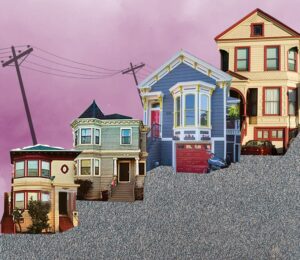I should preface by saying that I’ve been working toward studying abroad in Tokyo since I entered Mills College. At the moment, I’m listed by Mills as “abroad.” However, since the Japanese semester doesn’t begin until April, I’ve been in my hometown of San Jose since Winter Break. My flight leaves on April 7. The following is an account of my experience following the recent earthquake/tsunami in Japan.
I remember being on Twitter. Around 10:20 p.m. on March 10, I saw a post by the Associated Press, and read it aloud to my mother, who was nearby: “Magnitude 7.9 #earthquake strikes northern #Japan, swaying Tokyo buildings; #tsunami warning in effect: http://apne.ws/ep0AYc -JM”
My mother said, “Oh, that’s terrible! 7.9? Loma Prieta was only 6.9.”
My grandmother called after she saw the story on the 11:00 news to ask whether I’d heard.
My sister called from upstairs to ask whether I’d heard.
From that point, I began mindlessly scanning social media sites for information, posting any links I could find onto Facebook. The earthquake steadily grew from 7.9 to 8.9. Then there was the tsunami. There were photos of people being evacuated, sitting in Tokyo Disneyland to wait and see what would happen next, trying to contact their families. Tokyo Tower was bent and warped by the disaster. Then there was talk of nuclear plants being damaged. There were estimates of the death tolls. Around midnight Pacific Time, a tsunami warning was in effect for the American West Coast.
I went upstairs to wake and tell my mother.
“Mom? I don’t want to scare you, but there’s a tsunami warning in effect for San Francisco.”
“Seriously?”
“Yeah. It’s supposed to hit around 8:30.”
Once I was back downstairs, I sent out a few Facebook messages to friends in Japan.
At that point I was getting desensitized. I stared emptily at my laptop screen with a morbid curiosity as to what 8:30 a.m. would look like. The news and photos kept coming, but I could no longer bear the effort of reposting their links. I remember stuffing a few valuables into my purse — including a red envelope from Chinese New Year and a stuffed toy someone gave me for Valentine’s Day — just in case.
I sent myself to bed around 2:30 a.m.
The next morning, there were emails. My friends had all responded: They were all fine, and they thanked me for my concern. Mills had emailed me, too. It was something along the lines of “Are you okay? Are you safe? Do you need anything? We’re contacting your program!”
It was then that I realized that some believed I was already in Tokyo.
There was a similar email from my study abroad advisor, but she soon realized that I hadn’t left yet, and sent a second email to say so.
The study abroad program had also emailed its participants. They said that Sophia University in Tokyo itself was safe. None of the students or faculty were harmed.
“(The) trip will go ahead as planned.”
I responded to the emails as appropriate, and since then I’ve been responding to the same question almost daily: “Do you still want to go to Japan?”
The short answer is “Yes.”
My original plan had actually been to study in Tokyo for a full academic year. Those who knew me in the spring semester of 2010, though, know what I look like when I’m severely over-stressed. I was forced to reduce my trip to one semester during that time, and it hurt me so much that I promised myself I wouldn’t give it up again. As a second semester junior, this is my last chance. On top of that, my financial aid will expire after spring 2012. I’m not enrolled in classes at Mills this semester, and I literally can’t afford to graduate late.
While I’m truly touched by the concern expressed by those who know of my plans, for both personal and practical reasons, I can’t give this up.
Before the earthquake hit, whenever I told someone that I was going to Tokyo, they would say, “Oh! You’re so lucky!” They would picture the glittering Tokyo Metropolis. They would see the bright lights of Shibuya and its hectic scramble crossing. They would think of the vibrant pop culture scene and rich history.
Now, when I say “Tokyo,” the glitter is gone. They picture a disaster zone. They see people hurting and hungry. They see debris and floods. There are still aftershocks and planned rolling blackouts along the Japanese coast. The Shibuya lights and the scramble crossing have been turned off to conserve energy. Families have been lost and separated, and all methods of communication are strained and disrupted. I’ve even heard a story in my Japanese class about a woman in Chiba who took two days to find and purchase a flashlight.
However, there hasn’t been major structural damage to Tokyo itself. The epicenter of the quake was approximately 230 miles north of Tokyo, and most of the damage was really in Sendai. That isn’t to say that Tokyo is unaffected, but as a point of comparison: the epicenter Loma Prieta Earthquake in 1989 was actually in Santa Cruz, but more people still panicked over its effect on San Francisco. Likewise, the areas around Sendai are the most affected and are probably the sources of the more apocalyptic photos, but everyone is focused on Tokyo.
Despite everything, I’m confident that Japan can and will pull through. Japan has a history of devastation and survival and a national “never say die” attitude. For perspective: The Great Kanto Earthquake in 1923 was a 7.9. Its epicenter was about 62 miles south of Tokyo, and it completely devastated Tokyo and the cities surrounding it. Since then, the area has been rebuilt with earthquake safety in mind, the people have been prepared for any disaster that might strike, and the nation of Japan has risen to flourish in the modern era. Yes, the most recent earthquake was bigger. Yes, the Japan is hurt. Yes, they need help and support, but they will recover.
There has been such a range of responses: from extremely inappropriate comments by a few ignorant people linking the earthquake as revenge for Pearl Harbor to heartfelt relief efforts by various YouTube celebrities, musicians and locals. A friend of mine organized a musical street performance in San Francisco’s Japantown and had a jam session with his friends for four hours in the rain. They managed to collect just over $900 in donations for the Japanese Red Cross.
Yoshiki of X Japan — the most prominent Japanese rock band in history — flew from Los Angeles to Tokyo after hearing of the disaster to check on those close to him. He is currently planning to auction his famous, custom-made “crystal” piano, and will donate the proceeds to the relief effort.
Most recently, the US has been evacuating its citizens from Japan due to the increased nuclear activity. There’s particular focus on the 50 mile radius surrounding the Fukushima nuclear power plant (about 150 miles north of Tokyo). My mother is worried that I’ll be exposed to nuclear fallout, and we needed to look at a map together to reassure ourselves how far away the nearest nuclear plant is from where I’ll be studying.
The truth is that I’m getting nervous. The closer it gets to my departure date, the worse things seem to get. I don’t want to cancel this. I don’t want to give up just because I’m nervous. Whenever someone asks “Do you still want to go to Japan?” a part of me hears them say “Please change your mind.” Whenever I hear that, I smile and say, “Yes, I’m still going.”
This is an important time, and I’m kind of honored for the chance to be a part of it. It’s not going to be easy, but I’m not there for vacation.
UPDATE. Since writing this piece, Christina Macias has left for her study abroad in Japan.
You can read more related posts on The Campanil’s special page about the disaster in Japan.
Read Christina Macias’ other related posts:
1. Student headed to study abroad is not deterred by earthquake in Sendai, Japan
2. New beginnings in Tokyo during Hanami Matsuri season
3. Golden Week signals springtime in Japan


